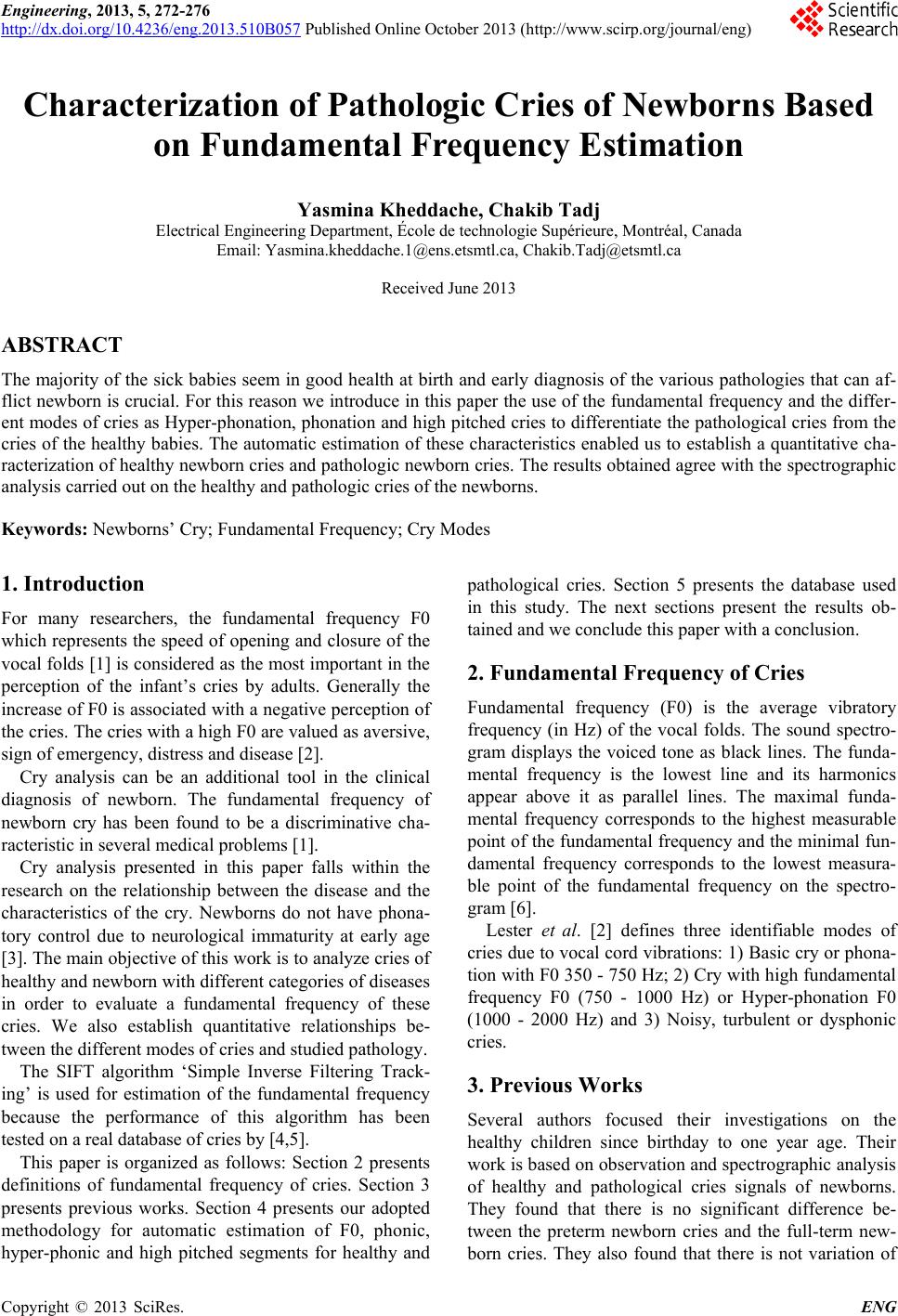
Engineering, 2013, 5, 272-276
http://dx.doi.org/10.4236/eng.2013.510B057 Published Online October 2013 (http://www.scirp.org/journal/eng)
Copyright © 2013 SciRes. ENG
Characterization of Pathologic Cries of Newborn s Based
on Fundamental Frequency Estimation
Yasmina Kheddache, Chakib Tadj
Electrical Engineering Department, École de technologie Supérieure, Montréal, Canada
Email: Yasmina.kheddache.1@ens.etsmtl.ca, Chakib.Tadj@etsmtl.ca
Received June 2013
ABSTRACT
The majority of the sick babies seem in good health at birth and early diagnosis of the various pathologies that can af-
flict newborn is crucial. For this reason we introduce in this paper the use of the fundamental frequency and the differ-
ent modes of cries as Hyper-phonation, phonation and high pitched cries to differentiate the pathological cries from the
cries of the healthy babies. The auto matic estimation of these characteristics en abled us to establish a quantitative ch a-
racterization of healthy newborn cries and pathologic newborn cries. The results obtained agree with the spectrogr aphic
analysis carried out on the healthy and pathologic cries of the newborns.
Keywords: Newborns’ Cry; Fundamental Frequency; Cry Modes
1. Introduction
For many researchers, the fundamental frequency F0
which represents the spe ed of opening and closure of the
vocal folds [1] is considered as the most important in the
perception of the infant’s cries by adults. Generally the
increase of F0 is asso ciated with a negative perception of
the cries. The cries with a high F0 are valued as aversive,
sign of emergency, distress and disease [2].
Cry analysis can be an additional tool in the clinical
diagnosis of newborn. The fundamental frequency of
newborn cry has been found to be a discriminative cha-
racteristic in several medical problems [1].
Cry analysis presented in this paper falls within the
research on the relationship between the disease and the
characteristics of the cry. Newborns do not have phona-
tory control due to neurological immaturity at early age
[3]. The main objective of this work is to analyze cries of
healthy and newborn with different categories of diseases
in order to evaluate a fundamental frequency of these
cries. We also establish quantitative relationships be-
tween the di f f erent modes of cries and st u died pathology.
The SIFT algorithm ‘Simple Inverse Filtering Track-
ing’ is used for estimation of the fundamental frequency
because the performance of this algorithm has been
tested on a real database of cri es by [4 ,5] .
This paper is organized as follows: Section 2 presents
definitions of fundamental frequency of cries. Section 3
presents previous works. Section 4 presents our adopted
methodology for automatic estimation of F0, phonic,
hyper-phonic and high pitched segments for healthy and
pathological cries. Section 5 presents the database used
in this study. The next sections present the results ob-
tained and we conclude this paper with a conclusion.
2. Fundamental Frequency of Cries
Fundamental frequency (F0) is the average vibratory
frequency (in Hz) of the vocal folds. The sound spectro-
gram displays the voiced tone as black lines. The funda-
mental frequency is the lowest line and its harmonics
appear above it as parallel lines. The maximal funda-
mental frequency corresponds to the highest measurable
point of the fundamental frequency and the minimal fun-
damental frequency corresponds to the lowest measura-
ble point of the fundamental frequency on the spectro-
gram [6].
Lester et al. [2] defines three identifiable modes of
cries due to vocal cord vibrations: 1) Basic cry or phona-
tion with F0 350 - 750 Hz ; 2) Cry with high fundamental
frequency F0 (750 - 1000 Hz) or Hyper-phonation F0
(1000 - 2000 Hz) and 3) Noisy, turbulent or dysphonic
cries.
3. Previous Works
Several authors focused their investigations on the
healthy children since birthday to one year age. Their
work is based on obs ervation and spe ctrograph ic analysis
of healthy and pathological cries signals of newborns.
They found that there is no significant difference be-
tween the preterm newborn cries and the full-term new-
born cries. They also found that there is not variation of